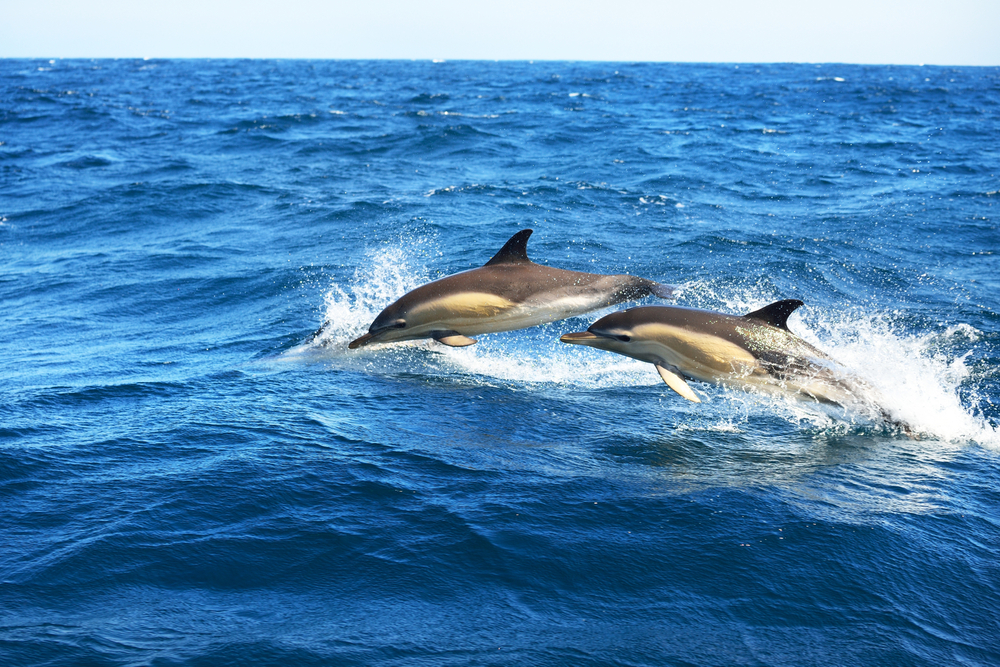The Mediterranean Sea is one of the most bio-diverse places in the entire world – and while you may not see everything from the surface level, you can bet that underneath the water there are tons of interesting critters swimming around. From flamboyant fish and unique crustaceans to seagrass and anemones, there’s much more to the Mediterranean than meets the eye.
Some of the most intriguing animals that call these waters home are dolphins – and there are 4 different species of them in the Mediterranean alone.
These highly intelligent creatures are much loved by humans, and whether you’re looking for the best place to spot some on your vacation or simply want to learn more about the different species, continue reading for more information about the 4 most common Mediterranean Sea dolphins.
Table of Contents
1. Striped Dolphin

The most common dolphin in the Mediterranean Sea is the Striped Dolphin. Although they can be found around the globe, they especially love the warm temperate and tropical waters of this inland sea.
Named for the black stripe on the center of its body, the average adult striped dolphin measures about 2 meters in length and can live up to 58 years of age. They travel in groups as small as 10, though some pods are comprised of hundreds of dolphins.
The striped dolphin prefers the deep expanses of the sea – so if you’re out on a boat, you might see pods swimming near the bow. Striped Dolphins aren’t shy, and are the most likely of any of the species to put on a show with frequent leaps out of the water.
These dolphins can swim mighty fast, with average speeds topping 15km (about 9 miles) per hour. They can also dive up to 700 meters to catch their prey, with the pelagic squid being a favorite. They don’t have many predators themselves, though climate change and illegal fishing practices are some of the biggest threats to this species.
2. Risso’s Dolphin

Another one of the most common Mediterranean Sea Dolphins is the Risso’s Dolphins. This is one of the most distinct-looking species of dolphins in the entire world, easily recognizable by their blunt-shaped head, unpronounced beak, and unusual white scars that they accumulate throughout their lives. Some of the oldest Risso’s dolphins actually appear to be almost white after a lifetime of collecting these scratches.
The Risso’s dolphin is longer than the striped dolphin, with average lengths ranging between 3.5 and 4 meters. This species prefers to frequent the deep pelagic waters of the Mediterranean (especially around submarine canyons and steep shelf slopes), though you can find them in almost every other temperate and tropical sea around the world.
Like most other dolphin species, the Risso’s dolphin prefers to travel in groups, with the average size being about 30. Pods in the thousands have been spotted before, but some have smaller groups of about 10.
Their diet consists mainly of cephalopods (think squids, cuttlefish, and octopus), and they do most of their hunting at night.
If you’d like to see one of these unique creatures while in the Mediterranean, your best chance is around Spain. The Balearic Islands are especially great for sightings, and if you’re lucky, you might spot a pod swimming alongside your boat.
3. Bottlenose Dolphin

The bottlenose dolphin is one of the most well-known dolphin species around the world – and it’s also one of the most common species in the Mediterranean Sea. Known for their playful nature and acrobatic skills, bottlenose dolphins are curious creatures that love to put on a show for any boats they encounter.
Unfortunately, this curiosity can often result in them getting too close to fishing nets and becoming entangled – ultimately, leading to premature death. It’s not just curiosity that leads them to become entangled in nets. Their diet consists of many of the same fish species that humans like to consume too, including Atlantic bonito, mackerel, tuna, and much more.
Overfishing, habitat destruction, and pollution have all lent a hand in the dwindling number of these species, but it is still possible to catch sight of these beautiful creatures while in the Mediterranean – especially around the island of Mallorca.
Their streamlined body is easy to recognize, but their coloring can vary from light grey to dark grey – and even pinkish in the warmer summer months. They measure between 2-4 meters in length and can weigh up to a whopping 500kg (over 1,000 pounds)!
Like most other dolphin species, their pod sizes vary greatly, with the smallest groups being between 2-10 dolphins and the largest pods ranging up into the thousands.
4. Short-Beaked Common Dolphin

The fourth and final dolphin species that call the Mediterranean Sea home is the short-beaked common dolphin. These were once the most common dolphin species in the Mediterranean, but due to habitat degradation, overfishing, and organized culling campaigns that were used until the 1970s, their numbers have been decimated.
Because the short-beaked common dolphin feeds on many of the same critters that are key to commercial fishing, like sardines, herring, and anchovies (among others), they were once considered pests – and killed in large numbers. Thankfully, this outdated process and other harmful practices like drift net fishing are no longer accepted, and the short-beaked common dolphin population is once again on the rise.
This species can also be found in the warm temperate and tropical waters of the Atlantic and Pacific Oceans and prefer to frequent the deep pelagic areas. Short-beaked common dolphin pods can reach up to several thousand individuals, but these large schools travel in smaller individual groups of around 20-30 dolphins.
The short-beaked common dolphin has a very distinct pattern, made up of an hourglass pattern of white, grey, and yellow. They average around 4 meters in length and can live to be up to 30 years of age.
Though sightings of these endangered creatures are rare, your best chance to spot a pod is around the southern shores of Spain. They are an extremely active species, so if you do see some, they’ll likely be jumping and performing impressive aerial stunts.

















